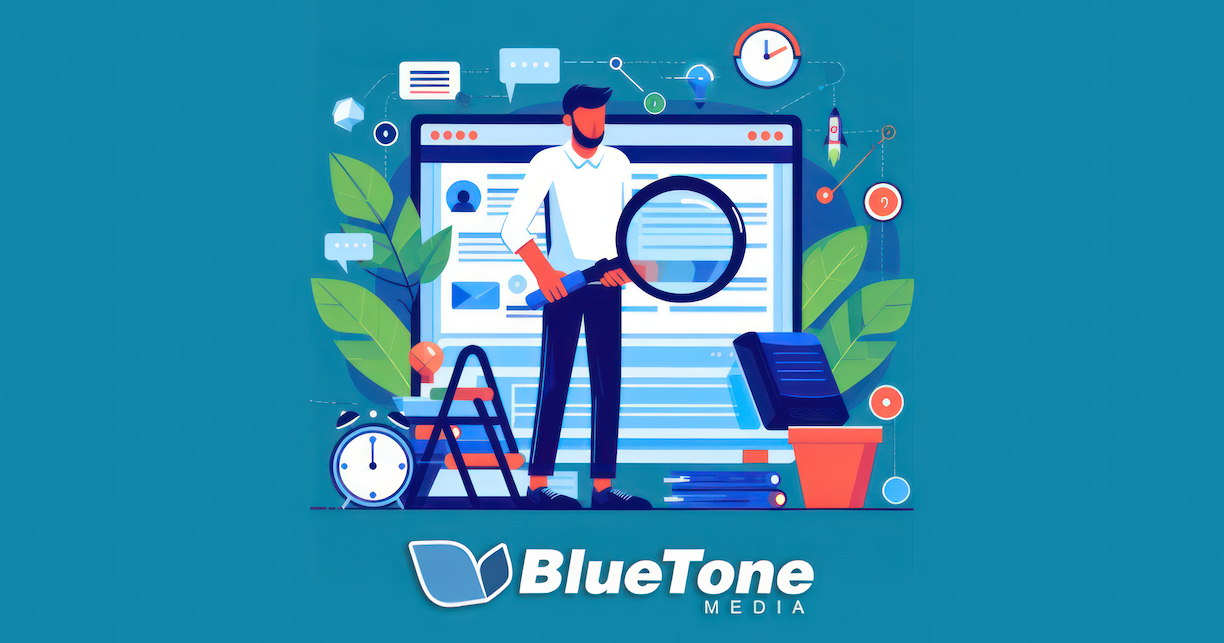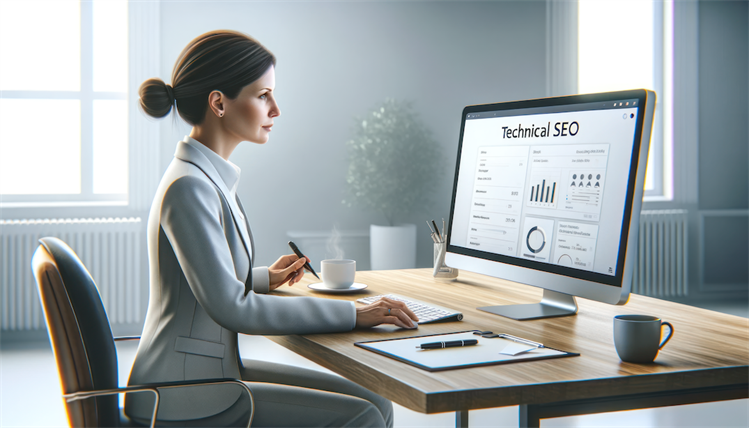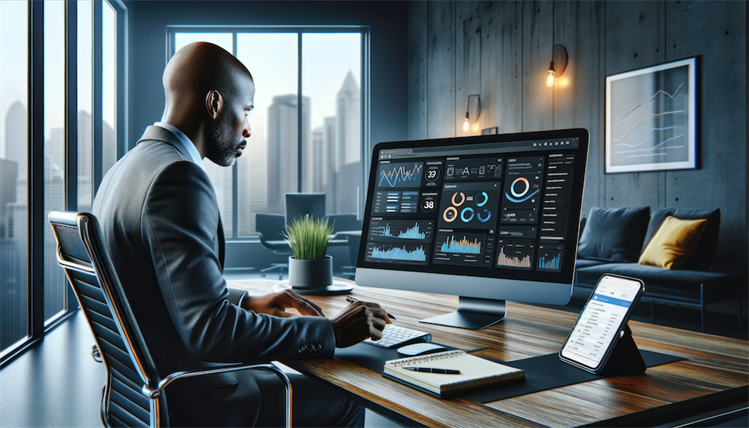On-Page SEO Tips for 2024
By: Hayden Jarman

In the ever-evolving landscape of digital marketing, mastering on-page SEO is crucial for businesses aiming to thrive online.
As we look towards 2024, adapting to the latest on-page SEO strategies will not only elevate your website's search engine rankings but also boost organic traffic significantly.
Table of Contents:
- Introduction to On-Page SEO
- Keyword Research for On-Page SEO Success
- Optimizing Website Content for Search Engines
- Meta Descriptions: Capturing Search Engine Attention
- Internal Linking: Weaving a Web of Relevance
- Technical SEO: The Foundation of Search Engine Success
- User Experience: Prioritizing Visitors for Search Engine Favor
- Frequently Asked Questions about On-Page SEO
- Enhancing On-Page Elements for SEO
- Advanced On-Page SEO Tactics
- Emerging Trends in SEO
- In-Depth Content Analysis
- SEO Tools and Automation
- Final Thoughts on On-Page SEO for 2024
Key Takeaways:
- High-quality content remains the cornerstone of on-page SEO.
- The strategic use of title tags, meta descriptions, and keywords is essential.
- Internal linking boosts SEO by demonstrating content relevance and aiding navigation.
- Technical SEO, including page speed and mobile-friendliness, is more important than ever.
- Regularly updating SEO strategies in line with algorithm changes is key to maintaining high rankings.
Introduction to On-Page SEO
A) Definition of on-page SEO
On-page SEO involves optimizing web pages to improve a website's search engine rankings and earn organic traffic. This includes both content and HTML source code that can be optimized, such as title tags, internal links, and URLs.
B) Importance of on-page SEO in 2024
With search engines becoming smarter, on-page SEO in 2024 is not just about keyword stuffing but providing a seamless user experience and high-quality content that answers the user's intent.
C) Benefits of effective on-page SEO
Effective on-page SEO strategies lead to:
- Higher search rankings
- Increased website visibility
- Better user engagement
Keyword Research for On-Page SEO Success
A) Identifying relevant keywords and phrases
The first step to a successful SEO strategy is identifying the right keywords. This includes understanding what potential customers are searching for and the language they use.
B) Utilizing keyword research tools
Tools like Google Keyword Planner and SEMrush provide valuable insights into search volumes and keyword difficulty, helping to shape your content strategy.
C) Understanding search intent and user behavior
Understanding why users search for certain terms is critical. Catering to user intent is a surefire way to improve content relevance and engagement.
Optimizing Website Content for Search Engines

Crafting content that ranks well on search engines begins with optimization. Here are key strategies to ensure your content is search-engine friendly:
A) Crafting compelling and informative content
Your content must be engaging and provide value to readers. It should answer questions, solve problems, or offer unique insights.
B) Incorporating target keywords naturally
Use keywords strategically and naturally throughout your content, avoiding overstuffing which can lead to penalties from search engines.
C) Ensuring content relevance and originality
Search engines prioritize content that is not only original but also thoroughly answers the search query.
Table 1: Keyword Research Best Practices
| Best Practice | Description |
| Long-tail keywords | Focus on keywords that are more specific and less common to attract a more targeted audience. |
| Search volume analysis | Identify keywords that have a significant search volume but not so high that the competition is insurmountable. |
| Competitor analysis | Review which keywords are bringing traffic to your competitors' sites. |
Meta Descriptions: Capturing Search Engine Attention
Meta descriptions play a crucial role in on-page SEO. They provide a brief summary of what users can expect from your webpage.
A) Writing clear and concise meta descriptions
Keep your meta descriptions within 150-160 characters to ensure they are not truncated in search results.
B) Including target keywords and benefits
Incorporate your main keywords while also highlighting the benefits of clicking through to your content.
C) Compelling users to click through
A well-crafted meta description acts as an advertisement for your content—make it irresistible.
Internal Linking: Weaving a Web of Relevance
A) Strategic placement of internal links
Internal links are a powerful tool for SEO. They guide users to relevant content, keeping them engaged on your site longer. For instance, understanding how a blog boosts SEO can be crucial for content strategies.
B) Connecting related content within the website
Linking related articles or pages on your website can significantly enhance the user experience and help search engines crawl your site more effectively.
C) Enhancing user navigation and search engine understanding
A logical link structure is beneficial for both users and search engines. It makes navigation intuitive and helps search engines understand the hierarchy and relationship between different pages of your site.
Table 2: Internal Linking Strategies
| Strategy | Description |
| Anchor text | Use descriptive anchor text for your internal links to inform both users and search engines about the topic of the link's destination. |
| Link relevance | Only link to pages that naturally complement or add value to the content from which you are linking. |
| Link placement | Place internal links high within the content to increase their visibility and likelihood of being clicked. |
Technical SEO: The Foundation of Search Engine Success

A) Optimizing website loading speed
A fast-loading website not only provides a better user experience but is also a factor in search engine rankings. Tools like Google's PageSpeed Insights can help identify areas for speed improvement.
B) Ensuring mobile-friendliness and responsiveness
With mobile devices accounting for over half of global internet traffic, it’s essential that your website is mobile-friendly. This SEO case study on a North Carolina solar contractor showcases the importance of responsive design.
C) Addressing technical issues and improving website structure
Regularly audit your site for broken links, incorrect redirects, and unoptimized HTML to maintain a solid technical foundation.
Table 3: Page Speed Optimization Techniques
| Technique | Impact |
| Image compression | Reduces file sizes to speed up page loading times. |
| Minifying CSS, JavaScript, and HTML | Removes unnecessary characters from code to improve performance. |
| Browser caching | Stores resources on local computers to decrease loading times on subsequent visits. |
User Experience: Prioritizing Visitors for Search Engine Favor
A) Creating an engaging and user-friendly website
The aesthetics of your website, its navigation, and the value it provides play a crucial role in retaining visitors and reducing bounce rates.
B) Prioritizing user needs and preferences
Understanding and catering to what your audience is looking for will increase engagement and, by extension, your SEO rankings.
C) Enhancing website accessibility and usability
Ensuring that your website is accessible to all users, including those with disabilities, is not only ethically right but also expands your reach.
Frequently Asked Questions about On-Page SEO
1) What are the best practices for on-page SEO in 2024?
- Create high-quality, original content that provides value to your audience.
- Optimize your title tags and meta descriptions to reflect the content of your page and include relevant keywords.
- Structure your content with proper heading tags to improve readability and SEO.
- Ensure your images are optimized with descriptive alt text and compressed for faster loading times.
- Improve user experience by making your site mobile-friendly and reducing page load times.
- Use internal linking to help users navigate your site and to help search engines understand the structure of your content. For example, you might find insights on SEO and marketing for lawn care and landscaping helpful when structuring your service pages.
2) How do I write effective meta descriptions that drive clicks?
- Keep them succinct: Aim for around 150-160 characters.
- Use active voice and action-oriented language: Encourage readers to take action.
- Include target keywords: Integrate your primary keywords to align with search queries.
- Provide a clear value proposition: Tell readers what they'll gain by visiting the page.
Table 7: Meta Description Optimization
| Element | Tips |
| Length | Keep under 160 characters |
| Call to Action | Use phrases like "Learn more" or "Discover how" |
| Value Proposition | Clearly state the benefit of reading the content |
| Keywords | Include 1-2 primary keywords |
3) How can I effectively use internal linking to improve my on-page SEO?
- Link to high-authority pages to pass on valuable SEO juice.
- Use descriptive anchor text that gives users and search engines context about the linked page.
- Keep it natural: Ensure that the links appear naturally in the content and are relevant to the topic.
- Distribute links evenly: Spread links throughout your content to provide balance and encourage deeper site exploration.
For instance, incorporating insights from SEO and marketing for wedding planners can illustrate how targeted internal linking strategies can drive industry-specific traffic.
4) What are some common technical SEO issues and how can I resolve them?
- Slow page load times: Optimize images, minify code, and leverage browser caching.
- Mobile usability issues: Use a responsive design and test your site with Google's Mobile-Friendly Test.
- Duplicate content: Use canonical tags to point search engines to the original content.
Table 8: Technical SEO Checklist
| Issue | Solution |
| Slow Load Times | Compress images, use CDN, minimize CSS/JS |
| Mobile Usability | Implement responsive design |
| Duplicate Content | Set canonical URLs |
In addition to addressing these FAQs, let's explore more on-page SEO elements that will be critical in 2024.
Enhancing On-Page Elements for SEO
A) Image Optimization
Images are a critical part of any website but can often slow down page speed if not optimized correctly. Use tools to compress images without losing quality and always include relevant keywords in your alt text. For a comprehensive guide, you might refer to SEO Image Size: A Comprehensive Guide to Image Optimization.
B) Structured Data
Structured data helps search engines understand the context of your content. Implementing schema markup can enhance the way your pages are represented in SERPs, potentially leading to a higher click-through rate.
Table 9: Structured Data Implementation
| Data Type | Use Case |
| Organization Schema | For company info like name, logo, and contact details |
| Product Schema | For detailed product information and pricing |
| Article Schema | For news and blog posts to highlight the headline and publication date |
C) Local SEO
For local businesses, optimizing for local search is paramount. This includes creating a Google My Business profile, getting listed in local directories, and ensuring your name, address, and phone number (NAP) are consistent across the web. SEO Localization plays a pivotal role in reaching a local audience.
D) Social Signals
While social signals may not be a direct ranking factor, they can reflect the popularity and relevance of your content. Engage with your audience on social media
to drive traffic back to your site and improve your brand's visibility.
Advanced On-Page SEO Tactics
As search engines evolve, so do the strategies to optimize content. Consider the following advanced tactics:
A) Voice Search Optimization
With the rise of smart speakers and virtual assistants, optimizing for voice search is becoming increasingly important. Focus on natural language and question-based queries.
B) Video Content
Video content can significantly increase user engagement. Embed relevant videos into your content and optimize video titles, descriptions, and tags for your target keywords.
C) Mobile-First Indexing
Google predominantly uses the mobile version of the content for indexing and ranking. Prioritize mobile optimization to ensure your site meets Google's standards.
D) User Engagement Metrics
Pay attention to user engagement metrics like time on page and pages per session. These can provide insights into the quality of your content and its relevance to your audience.
By implementing these on-page SEO tips and keeping abreast of the latest trends, your website can stand out in the competitive digital space of 2024.
As with any strategy, the key is to start with a solid foundation and build upon it, continuously testing and adapting to deliver the best possible experience to users while satisfying search engine algorithms.
Remember, SEO is an ongoing process, and success comes from staying informed, being adaptable, and consistently applying best practices across your website.
As we continue to forge ahead into the SEO landscape of 2024, let's delve into some additional tactics that can give your on-page SEO an edge over the competition.
By now, we've covered the basics and some advanced strategies. Now, it's time to look at some of the emerging trends that will shape the future of search engine optimization.
Emerging Trends in SEO
A) Artificial Intelligence and SEO
AI is changing how we approach SEO, from content creation to keyword research and beyond. Embracing AI tools can automate and refine your SEO strategies, making them more effective and data-driven.
B) Predictive Search
Search engines are increasingly able to predict user needs. Optimize for predictive search by understanding user behavior and aligning your content with the user's next potential action.
C) E-A-T (Expertise, Authoritativeness, Trustworthiness)
Google's E-A-T is becoming a critical part of SEO. Ensure your content is created by knowledgeable authors and backed by reputable sources to boost your site's credibility.
Table 10: Aligning with E-A-T Principles
| Principle | How to Align |
| Expertise | Author content with qualified experts in the field. |
| Authoritativeness | Gain backlinks from and citations by authoritative sites. |
| Trustworthiness | Secure your site with HTTPS and include clear privacy policies. |
D) Multichannel Optimization
It's not just about optimizing for search engines anymore. Ensure your content is optimized across different platforms to increase visibility and traffic.
In-Depth Content Analysis

A) Content Gaps and Opportunities
Identify what your competitors are missing and fill those gaps with your content. This can position you as a leader in your niche.
B) Skyscraper Technique
Take existing content that is performing well and create something better, more in-depth, and more valuable. This can help you outrank your competition.
C) Content Refreshing
Regularly updating old content keeps it relevant and can give it a new lease of life in search rankings. Remember, freshness can be a ranking signal.
SEO Tools and Automation
Leverage SEO tools to automate routine tasks, track your rankings, and get actionable insights. For instance, the case studies at BlueTone Media can provide an understanding of how real businesses achieve SEO success.
A) A/B Testing
Test different versions of your page to see which elements work best for your audience and lead to better conversion rates.
B) Analytics
Deep dive into analytics to understand how users interact with your site and what can be improved.
Table 11: Essential SEO Tools
| Tool Type | Purpose |
| Keyword Research | To find the right keywords to target. |
| On-Page Analysis | To optimize individual page elements. |
| Rank Tracking | To monitor SERP positions over time. |
| Backlink Analysis | To assess and monitor backlink profiles. |
Final Thoughts on On-Page SEO for 2024
As the digital world becomes ever more competitive, ensuring that your website is optimized for search engines is vital. Whether you're starting your SEO journey or looking to refine your strategy, BlueTone Media is here to guide you every step of the way.
If you're ready to elevate your online presence and drive substantial organic traffic to your site in 2024 and beyond, reach out to the experts.
Contact BlueTone Media through their contact page or speak directly with a specialist by calling 888.258.8663 now.
Don't miss the opportunity to lead in the digital space with a winning on-page SEO strategy crafted by professionals.
Related Posts:
- Understanding Google’s Local Pack: How to Get Featured
- Google Business Profile FAQs: Everything You Need to Know
- The Best Google Ads Extensions to Boost Your Click-Through Rates
- How to Leverage Facebook Groups for Local Business Leads
- How to Use AI to Write Better Social Media Captions
- How to Optimize Google Reviews to Attract More Customers
- LinkedIn for B2B Marketing Success
- How to Conduct a Social Media Audit (w/ "Audit Readiness" Quiz!)
- Creating a Content Calendar for Consistent Posting
- The Importance of Mobile Optimization in 2024
- Data Privacy Regulations: What Marketers Need to Know
- The Role of Chatbots in Enhancing Customer Service
- SEO for Small Business: The Ultimate Guide to Getting Found Online
- The Role of Keyword Clustering in Modern SEO

